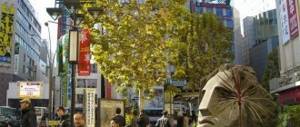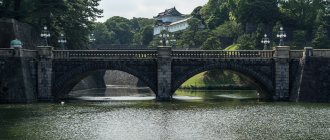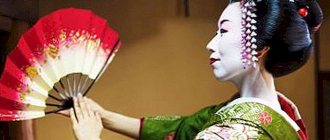Japan has many impressive castles, most of which were built during periods of military conflict. During the period called Sengoku, Japan consisted of several dozen small states that fought each other non-stop. That is why from the middle of the 15th century to the beginning of the 7th century many castle-fortresses were erected.
But the Second World War was also very destructive for Japan, and most of the castles suffered too much. Only twelve buildings have survived, and five of them have received the status of national treasures.
Matsumoto Castle
The building's two main towers were erected for defense purposes. Another Matsumoto tower was created for a ceremonial purpose: to contemplate the moon.
This ancient structure is sometimes also called “Black Raven’s Castle.” It is located just three hours from the country's capital, Tokyo. Matsumoto Castle is one of the most popular among travelers. And there is nothing surprising here: after all, having first immersed themselves in the progressive Tokyo atmosphere, then tourists want to visit something ancient, covered in the spirit of archaism.
Matsuyama
The building is on top of a large hill. But it will be easy for travelers to get to the building, since there is a lift here. The territory of Matsuyama Castle contains a whole ensemble of buildings made in a traditional style. The foundation of the building was laid at the beginning of the 17th century. Some towers, unfortunately, burned down during a fire that occurred in the middle of the 20th century; Some of the buildings were destroyed during the terrible times of World War II. But since 1966, the castle began to be diligently restored, so that now its magnificent appearance attracts fans of Japanese culture from all over the world.
Odawara
Built back in 1418, this castle repeatedly took part in military battles and sieges. Initially, Odawara was surrounded by a moat and a high earthen rampart, which turned it into an almost impregnable fortress. Now Odawara has the status of a national cultural monument.
The park on the castle grounds is a favorite place to admire cherry blossoms. Some trees were planted back in 1920.
The castle can be reached from Tokyo. The journey will take no more than 35 minutes.
Architecture of the complex
The Imperial Palace is a modest long snow-white building made of reinforced concrete, similar to a hangar, consisting of seven buildings and surrounded by fluffy black pine trees. The castle has two above-ground floors and one underground. There is no wealth or luxury in the Japanese Imperial Palace - the architecture is elegant, strict and simple.
A huge territory of 741 hectares is surrounded by powerful, strong walls and wide protective ditches and two picturesque bridges. The walls are made of roughly hewn stone, the ditches are filled with blue-black water.
Along the perimeter of the castle near the moats there are watchtowers . The palace is surrounded by a huge natural park where magnolias and sakura, pine and maple trees grow, creating a palette of amazing colors. There are neat pine trees on the immaculate green lawn.
Spreading gardens and trees, magnificent watchtowers bring the magic of antiquity into the crazy rhythm of metropolitan life.
Along the artificial reservoir there is a garden and irises, and there are carps in the pond. The palace is a reminder of the undiminished authority of the ruling dynasty, whose symbol is the 16-petal chrysanthemum. The entrance to the residence is protected by a gate, where soldiers of the imperial guard keep watch, who throughout the entire existence of the dynasty have never had to repel enemy attacks.
Osaka Castle
One of the most impressive historical buildings in all of Japan. Osaka Castle occupies a huge area - about 1 square kilometer. The building was founded in the 16th century; its main purpose was to protect trade roads from attacks. Osaka was originally planned as the center of the great Toyotomi clan; however, in 1615 the structure fell under Tokugawa rule. In the past, the castle was literally filled with gold, which Toyotomi himself was very partial to. Some of Osaka's interior rooms were entirely decorated in gold.
Interiors
The interiors of the Imperial Palace are in Japanese style and decorated with precious wood. The 15-room residence of the emperor is his permanent place of residence. According to Japanese tradition, the emperor cannot leave the palace and remains within its boundaries throughout the entire period of his reign.
Inside the castle there are halls and rooms :
- Office.
- Dining rooms.
- Rooms for receiving guests.
- Vintage banquet hall.
- The imperial office for the monarch to conduct state affairs.
- The throne room for ceremonies and coronations of the new emperor.
- The Spring and Autumn Hall is for evening receptions.
- Harmony Hall - for relaxation.
Tourists admire the imperial palace from afar; only the Inner Garden is open to the public, from where you can sometimes see members of the imperial family appearing before the public on the glassed-in balcony.
The emperor and his wife live in the forbidden part, and here is a treasury with the attributes of imperial power and the Office of the Imperial Palace. The building has European curtains. The palace has an official website in English and Japanese.
Himyouji
This is practically the only historical building in Japan that was not destroyed by war or earthquake. Himyoji (or Himeji) has another poetic name - “White Heron Castle”, or “White Castle”. In some movies, viewers have the opportunity to see details of Himyozi. For example, in the Hollywood film “The Last Samurai” starring Tom Cruise.
Himyoji is now under the protection of UNESCO. The castle consists of 83 buildings, most of which are wooden. Not far from the main building there is a special courtyard called “harakiri-maru”. It was here that valiant samurai had to commit hara-kiri - ritual suicide. But according to researchers, nothing like this actually happened in the Harakiri Maru.
One of the most exciting activities for travelers is to wander through the intricate labyrinths of Himyoji. They were created specifically to mislead enemies.
The Art of Siege
Castles have become an important factor in Japanese history. For a long time they hindered, but in the end one fortress helped unify the country. The defense of Fushimi Castle in 1600 played a major role. 62-year-old Torii Motomada, a servant of the future shogun Tokugawa Ieyasu, commanded a garrison of two thousand.
Fushimi was attacked by the 30,000-strong army of Ishida Mitsunari. Isis sent soldiers in brutal attacks on the fortress, but its defenders bombarded the attackers with stones and bullets from arquebuses. For 11 days, Fushimi steadfastly defended himself and could have continued the fight if not for the merciless blackmail of the besiegers. One of the besieged betrayed his castle, as Ishida Mitsunari threatened to crucify his family, who had previously been captured.
The traitor managed to set fire to and destroy the tower and a section of the wall.
Defense of Fushimi. Source: Turnbull S. “Japanese Castles”
As a result, the castle was taken, although Torii Mototada continued to resist almost to the last soldier. He led counterattacks, one after another, until he had only ten men left.
Toriya has one last task left - to die with honor by committing seppuku. But an enemy rushed towards him - the samurai Saiga Shigetomo, who was about to take the head of another enemy. Torii called out his name, and out of respect, Shigetomo stopped, allowing the commander of the Fushimi defense to complete the killing ritual. Only after this did he cut off Mototad's head.
Mitsunari took this castle, but lost 3 thousand people under it, while Tokugawa had time to gather his forces. Soon his army defeated the weakened army of Mitsunari, and after Tokugawa became the ruler of Japan.
Tokugawa Ieyasu. Source: ru.wikipedia.org
The defense of Fushimi is an example of a very short siege. Huge armies could make futile attempts to take any fortress, and such campaigns sometimes lasted for months and even years.
Before the rapid development of stone fortification in the 16th–17th centuries. everything was simple: the besiegers usually stormed gates or walls directly head-on, trying first of all to set fire to the wooden fortifications with incendiary arrows or other flammable materials. Covering themselves with wooden or bamboo shields, the warriors launched an assault, set up ladders and tried to climb the walls.
With stone fortifications, everything became more complicated (and above all, the use of the previously main method of siege - arson). Samurai learned not only to engage in honorable hand-to-hand combat, but also to perform inventive tricks.
The fortresses were surrounded by traps - protruding stakes, embedded with sharp bamboo stems and metal spikes (analogous to the Russian “garlic”). Therefore, during sieges it was necessary not only to ensure multiple numerical superiority, but also to show ingenuity and actively use the art of engineering.
Siege towers, undermining and mining, bribing residents from among the besieged, systematic sieges with the aim of blockading the castle and starving it out, draining and poisoning water sources in the fortress, etc. also became widespread.
Without cunning, some castles simply could not be overcome. In 1614, 20 thousand Tokugawa warriors were unable to take Osaka, which was defended by a small garrison. A peace had to be concluded, under the terms of which the ruler of Osaka, Toyotomi Hideyori, agreed to fill up the external ditches. As soon as he did this, the enemy, of course, was again at the gate. This time the castle was taken, and Toyotomi Hideyori himself and his mother committed suicide. Their family has sunk into history.
Defense of Osaka. Source: Pinterest
Kato Kiyomasa (1561 - 1611), nicknamed the “devil commander,” also conquered fortresses with his wits. When necessary, he could order at night to cut off the rice stalks in the fields and fill the enemy's ditch with tied sheaves - by the morning his warriors were already on the walls. On another occasion, he invented the "tortoise shell" - a cart covered with dried thick skins.
The samurai under the “shell” approached the fortress, dismantled a section of the wall and then broke into the breach.
Kato Kiemasa. Source: ru.wikipedia.org
Toyotomi Hideyoshi became famous for his brilliant ingenuity during the siege of Takamatsu Castle in 1582. The commander noticed that the fortress stood in a lowland near the Asimori River. By his order, a dam of 4 km was built, and river water was diverted to it. After this, the dam was destroyed, and Takamatsu Castle was flooded. The garrison was so frightened that they surrendered to the will of Hideyoshi.
Siege of Takamatsu. Source: sengoku.ru
Flooding of Takamatsu. Source: flashbak.com
In the 1620s. Active construction of castles in Japan ceased. Feudal fragmentation and wars were behind us, and fortresses lost their importance. Some of the strongholds were destroyed, and the shogun forbade the establishment of new ones - so that the daimyo of a united Japan would be less willing to take up the old and destroy the political unity achieved with blood.
This ban became the best proof of the effectiveness of stone castles in the conditions of Japanese military art.
***
A significant part of Japanese castles, perceived as a symbol of outdated feudalism and the era of the samurai, were destroyed in the second half of the 19th century. The Second World War also brought destruction (for example, a castle in Hiroshima was destroyed by an atomic bomb and later restored). More than 50 Japanese fortresses from the Middle Ages and Modern times have survived to this day.
Edo Castle
It was built in the 15th century, but Edo reached its peak after the change of owner in 1868. Then Emperor Meiji himself came here from Kyoto. Currently, the external part of the ensemble is available for visitors to visit - these are the towers, the bridge and the park. You can see the inner complex of Edo only twice a year - on December 23, when the birthday of the current emperor is celebrated, and on January 2, in honor of the New Year.
Other structures
Other castles in Japan are also noteworthy:
- Gifu . It is located at an altitude of about 329 m above sea level.
- Nagoya . An ancient castle located in the area of the same name.
- Inuyama . Located on a hill above the Kiso River. It is considered the oldest building in all of Japan. The foundation of Inuyama Castle was laid in 1440.
- "Carp Castle" . Located in Hiroshima County. During the war it was destroyed, but in our times the building has been completely restored.
- Nijo . This castle is located in Kyoto. Included in the list of national treasures of Japan.
It is also worth visiting Hikone Castle, located in the Shiga region. Construction of the building began in 1603. In 1952, it became part of the country's national heritage.
2Matsue Castle
This castle is located near Lake Shinjiko, located in the city of Matsue (Shimane Prefecture). Because of the walls painted black, it was nicknamed the “Black Castle”. Construction of Matsue was started by Lord Horio Yoshiharu around 1607. The fortress has never seen battles, as it was built after a period of brutal feudal wars.
Since 1638, it has belonged to the Matsudaira clan for ten generations - for 234 years. During the Meiji period, it was confiscated from its owners and underwent a major restoration. Every year a festival is held there, combined with the procession of Matsue warriors. The castle is very popular among tourists as it offers stunning views of the entire city of Matsue and Lake Shinji.










